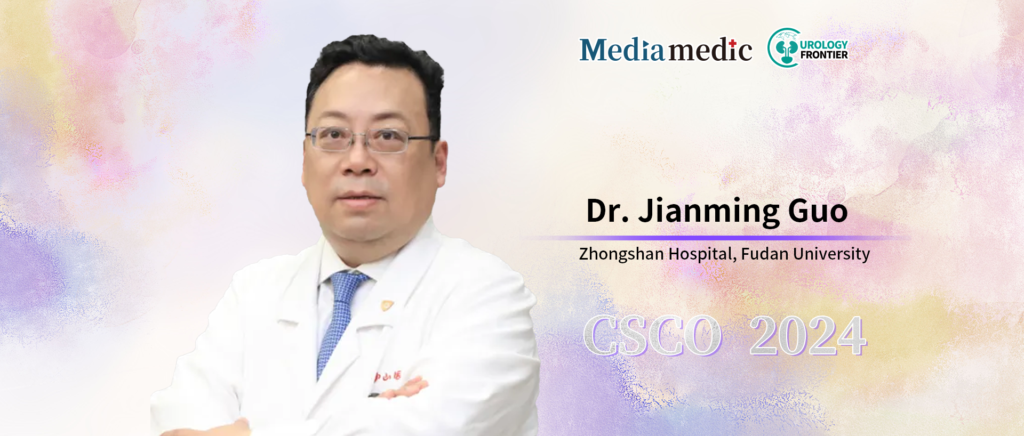
Editor’s Note: Surgical treatment is a crucial approach for prostate cancer, with radical prostatectomy being the gold standard. Even for intermediate and advanced prostate cancer, surgery can offer the possibility of clinical cure. For rare subtypes and complex cases, decisions often require multidisciplinary team (MDT) discussions and thorough communication with the patient. During the recent CSCO Annual Meeting, Urology Frontier invited Dr. Jianming Guo from Zhongshan Hospital, Fudan University, to share insights on the current state of prostate cancer diagnosis and treatment in China, recent research results, the standardized development of MDT, and the future directions for the urology team.1. What are the Current Needs of Prostate Cancer Patients in China?
Dr. Jianming Guo: Prostate cancer is one of the most common malignant tumors among men globally. Although the incidence rate among Asian populations, such as in China, is relatively lower compared to Western countries, it has been rising in recent years, making prostate cancer the sixth most common malignancy among men in China. There are three major challenges we face in preventing and treating prostate cancer in China:
Firstly, Western countries implemented early screening, early diagnosis, and early treatment years ago, enabling the early detection of prostate cancer. In contrast, the proportion of early-stage prostate cancer detection in China remains low. Many patients are only diagnosed after experiencing symptoms or during other examinations. While regions like Shanghai offer free screening for men over 65, participation rates are still low. As we continue to promote screening efforts, the number of early-stage patients is gradually increasing, which is crucial in narrowing the survival gap between patients in China and developed countries. In fact, China’s surgical capabilities are on par with those in Western countries, but late diagnosis has impacted treatment outcomes.
Secondly, surgical equipment requires attention. Modern radical prostatectomy is no longer a traditional open surgery but is performed through minimally invasive techniques such as robotic-assisted laparoscopic surgery. This method provides clearer visualization, reduces positive surgical margins, and offers better outcomes in terms of urinary control and sexual function preservation. However, such advanced equipment is not yet widely available in China. While some large hospitals have access to this equipment, its availability is limited, and many smaller hospitals lack it altogether. We hope that this high-end technology will be more widely promoted to improve surgical outcomes.
Finally, while numerous international clinical trials have explored treatments for advanced prostate cancer, only some centers in China have participated, and the approval of new treatments has not kept pace. Although we have access to basic medications, some newer drugs have been approved in China but are not yet included in the National Reimbursement Drug List (NRDL) or the centralized procurement system, limiting access for many patients. Addressing these challenges should be a priority in our efforts to prevent and treat prostate cancer.
2. Several recent meetings, including CSCO and ESMO, have presented the latest research in prostate cancer. How do you view these developments?
Dr. Jianming Guo: Each year, major international conferences like CSCO and ESMO unveil new research that significantly advances the field of prostate cancer diagnosis and treatment. However, it’s important to recognize that any new findings must stand the test of time and undergo repeated validation. This year, several key areas saw notable progress, and some deserve deeper exploration.
There is ongoing debate about whether neoadjuvant therapy should be used for locally advanced prostate cancer and, if so, which drugs should be used. Some studies presented this year showed benefits from using novel endocrine therapies combined with androgen deprivation therapy (ADT) as neoadjuvant therapy before surgery. These treatments have improved surgical outcomes by reducing positive margins, minimizing complications, and increasing resection rates. However, these results require longer-term follow-up and larger sample sizes to evaluate their impact on overall survival (OS).
In the treatment of metastatic prostate cancer, research in recent years has primarily focused on castration-resistant prostate cancer (CRPC). Now, the trend is shifting towards earlier treatment during the metastatic hormone-sensitive prostate cancer (mHSPC) stage. The ARANOTE trial is a prime example of this shift. Previously, the ARASENS trial demonstrated that a triple therapy combining darolutamide, docetaxel, and ADT significantly reduced the risk of death by 32.5% (HR 0.68, P<0.0001). However, not all patients are willing to undergo chemotherapy, and some achieve good outcomes with just endocrine therapy. This has led to some uncertainty for clinicians. The ARANOTE study provided answers, showing that a dual therapy of darolutamide plus ADT can also deliver substantial clinical benefits without chemotherapy (darolutamide reduced the risk of radiographic progression or death by 46% in mHSPC patients, P<0.0001), offering more treatment options for mHSPC patients.
Additionally, we are seeing increased use of radioligand therapies in prostate cancer, such as radium-223 and 177Lu-PSMA-617. These therapies, initially used in CRPC, are now being explored in earlier mHSPC stages. Combining them with novel endocrine drugs like enzalutamide may extend radiographic progression-free survival (rPFS). As one of the earliest centers in China to conduct radium-223 clinical trials, we look forward to further improving the cost-effectiveness of these therapies and, with time, achieving OS benefits for patients.
Overall, while this year’s advancements in prostate cancer treatment are significant, we must remain objective, conducting long-term follow-up and deep research into these new developments. It’s crucial to focus on the impact these treatments have on OS to ensure we are offering patients the safest and most effective treatment options.
3. Multidisciplinary Team (MDT) discussions are an essential part of prostate cancer diagnosis and treatment. How do you think we can standardize MDT development in grassroots hospitals?
Dr. Jianming Guo: MDT plays a crucial role in cancer treatment, but we must also avoid over-relying on it. Not all cancer cases require MDT. For instance, simple bladder tumor resections have relatively straightforward treatment plans. However, for complex bladder malignancies, such as non-urothelial or small-cell bladder cancers, involving multiple specialties like medical oncology and radiotherapy is necessary to develop a more precise treatment plan based on professional expertise and the latest research.
Let’s take bladder cancer as an example. For patients with recurrent bladder tumors after resection, MDT discussions are needed to determine whether bladder preservation or radical cystectomy is the best course of action. This decision involves not only medical expertise but also the patient’s preferences and overall health. Bladder preservation may include local treatments and systemic therapies like BCG instillation, GC chemotherapy regimens, or PD-1 immunotherapy. Additionally, for commonly used radiotherapy regimens abroad, collaboration with radiotherapy departments and the accumulation of data on Chinese patients are essential to guide the practice of bladder preservation.
Grassroots hospitals may face challenges in establishing MDTs, such as a lack of nuclear medicine departments that can perform isotope scans, bone scans, PET scans, or radium-223 therapy, and some hospitals may lack radiotherapy departments. To address these challenges, collaboration through hospital networks can help. At Zhongshan Hospital, Fudan University, we’ve created a medical alliance with hospitals like Xuhui District Central Hospital, Minhang District Central Hospital, Wusong Hospital, Shanghai Geriatric Medical Center, and Zhongshan Hospital Xiamen Branch. This alliance operates like a close-knit family, using remote consultations and other methods to enhance MDT outcomes, ensuring that more patients receive high-quality medical care.
4. What future directions will your team explore in the field of prostate cancer?
Dr. Jianming Guo: As urologists, our focus is on improving surgical outcomes. Throughout the treatment process, we must continue exploring how to accurately select surgical candidates and determine which patients will benefit most from surgery. For example, there is still debate over the exact definition of oligometastatic prostate cancer (in terms of the number of metastatic sites), and research is needed to determine whether these patients can benefit from surgery. Additionally, as the age range of surgical candidates expands, it is worth discussing whether surgery is appropriate for patients over 80 years old.
We are continuously striving for innovation and improvement in surgical techniques and approaches. At Zhongshan Hospital, Fudan University, our team performed the world’s first robot-assisted laparoscopic radical prostatectomy via a transvesical retropubic approach. This surgical innovation aims to achieve two primary goals: first, to restore urinary continence as quickly as possible and protect the nerves; second, to provide a convenient approach for patients with a history of lower abdominal surgery, avoiding the complications associated with scar tissue from traditional approaches and thus increasing their chances of undergoing a radical procedure.
Postoperative recovery is another focus area. In many Western countries, patients are often discharged home on the same day of surgery, thanks in part to advances such as eliminating the need for drainage tubes. Although some patients in China may be more conservative in their views, we should actively promote the concept of enhanced recovery and encourage early discharge and a return to normal life. Of course, all technical improvements should ultimately benefit patients. Only when patients truly benefit from these advancements should they be widely adopted. In short, we will always uphold the principle of “putting patients first.”
Dr. Jianming Guo
Professor, Chief of Urology, Zhongshan Hospital, Fudan University Standing Committee Member, Urology Branch of the Chinese Medical Doctor Association Member, Oncology Group of the Urology Branch of the Chinese Medical Association Vice Chairman, Urology Branch of the Shanghai Medical Association Vice Chairman, Urological Oncology Committee of the Shanghai Anti-Cancer Association Vice Chairman, Urology and Andrology Committee of the Shanghai Association of Integrative Medicine Standing Committee Member, Urological Oncology Committee of the Chinese Anti-Cancer Association Standing Committee Member, Prostate Cancer and Urothelial Cancer Committees of the Chinese Clinical Oncology Society Vice Chairman, Urology Branch of the Chinese Sexology Association Standing Committee Member and Deputy Secretary-General, World Chinese Urological Surgeons Association Deputy Chairman, Urology Branch of the Cross-Strait Medical Exchange Association Vice Chairman, Urology and Andrology Committee of the Chinese Association of Gerontology and Geriatrics


